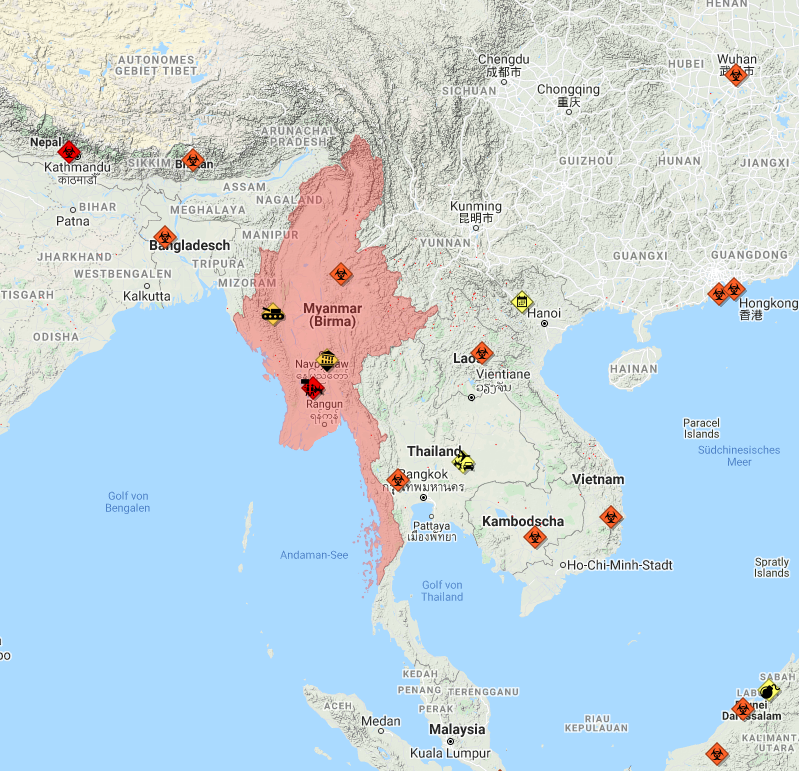A Tragedy Repeats: Is Myanmar the next Syria?
A paralysed UN Security Council, a deadly crackdown in the face of a popular mass movement, hundreds of thousands in flight, and brutalized protesters taking up arms. The parallels between the deteriorating situation in Myanmar and the early stages of the Syrian disaster are as disconcerting as they are many – and they are multiplying. What began as a civil disobedience campaign against yet another military coup in a historically coup-plagued country slowly morphed into a popular uprising and now looks set to turn into a full-scale civil war. Can the crisis in Myanmar still be prevented from escalating further or is the country heading for a disaster of Syrian proportions?
Escalation of a Coup
When on 01 February the Tatmadaw, as Myanmar’s military is also known, deposed the government, the military leadership clearly did not anticipate this much push-back. After all, for a country that had been under military rule for close to half a century, the coup seemed more like a return to the status quo than a disruption of it. Accordingly, the Tatmadaw found itself at a loss with how to react to the leaderless and highly innovative mass protest movement spontaneously springing up in hundreds of Myanmar’s cities. Worse, mass protest was also accompanied by mass civil disobedience of civil servants, health care workers, banking employees, teachers, and many more, effectively bringing the country to a grinding halt.
Confronted with such vehement popular resistance, the Tatmadaw has fallen back on rule by fear to maintain control of the country: Night raids, arbitrary arrests, extrajudicial executions, and army marksmen shooting to kill. Hundreds of people are confirmed to have been killed and thousands more have been arrested, with the real numbers likely to be significantly higher. In response, protesters have started to form self-defence units that a oppositional “National Unity Government” now seeks to forge into a ”People’s Defence Force” – all developments reminiscent of the early Syrian conflict.
Similar, but not the Same
To be sure, there are also pronounced differences to the situation in Syria. For instance, although Russia is seeking closer ties with the military junta in Myanmar, at the moment there is little indication that the situation could devolve into a Syria-style multi-sided proxy war. This is mostly due to the fact that Myanmar had already been involved in an ethnic-based multiparty civil war long before the current crisis. This conflict, that has been going on virtually since the country’s independence, has been marked by ethnic violence, war crimes, and massive human displacements of which the infamous ethnic cleansing campaign against the Muslim Rohingya has only been the most egregious example. Yet, despite decades of inter-ethnic violence Myanmar’s different ethnic and religious groups have been united in their opposition to military rule and support of the protests. Even some of the country’s rebel groups are intensifying their operations against the Tatmadaw and starting to train the brutalized protesters.
The Makings of a Humanitarian Disaster
With armed clashes and casualty number rising rapidly, the imminent humanitarian disaster within the country has remained largely out of focus. Already hard hit by the COVID-19 pandemic, Myanmar’s economy has been crippled by the civil disobedience campaign and is projected to shrink by up to 20%. Job losses are multiplying, cash is increasingly hard to come by, hundreds of thousands are on the run, and the UN estimates that 3.4 million Myanmarese will be unable to afford food in the coming months. On top of that, the health care system has essentially collapsed which includes the testing for and treatment of COVID-19. This is already a recipe for a humanitarian disaster, but should the situation deteriorate further the growing trickle of refugees to neighbouring countries could turn into a massive stream. Thereby, not just destabilizing Myanmar’s neighbourhood, but very likely also significantly exacerbating the pandemic in the region.
A Country at a Crossroads
A hundred days after the coup, there appear to be no obvious off-ramps. The UN Security Council is unable to offer anything but verbal condemnations of the violence due to Chinese and Russian obstinacy. Even though, multiple countries have levelled sanctions against the military junta, their impact is largely symbolic. Inside the country, opposition to the coup in the population is hardening and there are growing signs that formerly peaceful protesters are increasingly willing to take up arms. Conversely, the military junta has spilled too much blood and engendered the hate of too many people to just back down now. As this stand-off continues Myanmar is edging ever closer towards state failure and might very well be heading for yet another protracted civil war. While this situation may not be an exact repetition of the Syrian tragedy, it certainly would appear to rhyme with it.

